- Joined
- Oct 16, 2010
- Messages
- 5,695
Now it's time to apply the scales and liners. I modified a Universal 76 frame clamp to do this and I get great results. The scale face that mates with the guard is cut at 1 1/2 degrees because my tang tapers are so radical. Cutting the back of the scale to be parallel with the mating face is necessary to get a good tight fit when using the clamp to push the scale against the guard. I use four clamps to secure the scale to the tang after the rear clamp pressure is applied.
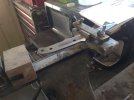
The fixture holds the knife by the ricasso and correctly orients the tang to drill the corby rivet holes......two wedges are placed under the scale to prevent flexing during drilling.
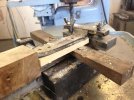
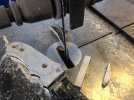
The lanyard tube is roughed in the drill press in order to give the glue something to bite on.
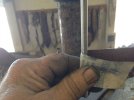
Finally the 1/4" pilot holes are counterbored with a step drill for the 5/16" stainless corby rivets.
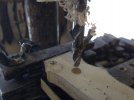
After the corby rivets are inserted the whole handle and guard is shaped. I keep a bucket of water close by - if the guard is allowed to get too hot, the solder joint will melt and run. A final word on ivory micarta - the stuff is beautiful but hard to work. Sharp belts, low speeds and a lot of hand sanding is in order because it smears if it gets too hot. The knife handle will be shaped, then hand sanded to 2500 grit with a green matchless buff between each grit to reveal the scratches. I always charge an upgrade fee when using ivory micarta because of the extra labor involved - sorry Joe!! Lately, I've starting using Masecraft Supply's "alternative ivory" which is good stuff.
Here's the finished knife with maker's mark, ready for leather.
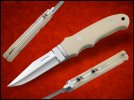

The fixture holds the knife by the ricasso and correctly orients the tang to drill the corby rivet holes......two wedges are placed under the scale to prevent flexing during drilling.


The lanyard tube is roughed in the drill press in order to give the glue something to bite on.

Finally the 1/4" pilot holes are counterbored with a step drill for the 5/16" stainless corby rivets.

After the corby rivets are inserted the whole handle and guard is shaped. I keep a bucket of water close by - if the guard is allowed to get too hot, the solder joint will melt and run. A final word on ivory micarta - the stuff is beautiful but hard to work. Sharp belts, low speeds and a lot of hand sanding is in order because it smears if it gets too hot. The knife handle will be shaped, then hand sanded to 2500 grit with a green matchless buff between each grit to reveal the scratches. I always charge an upgrade fee when using ivory micarta because of the extra labor involved - sorry Joe!! Lately, I've starting using Masecraft Supply's "alternative ivory" which is good stuff.
Here's the finished knife with maker's mark, ready for leather.

Last edited:


